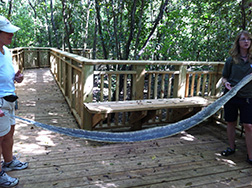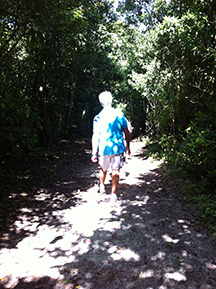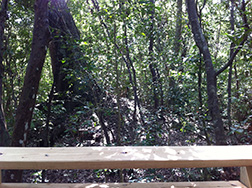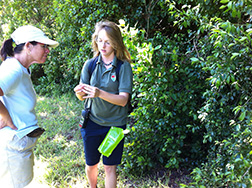Posted November 11, 2012
By LAURA YEPES
MIAMI, Fla. — Catherine Berendsohn held up the large tooth in between her thumb and forefinger for the group to see. It was approximately two and a half inches long with the enamel still intact.
“It definitely is a canine,” said Andrea O’Hagan, a dental assistant and participant in the group tour.
I just stared in awe. That chewing machine the size of my forefinger was dug up in the Old Cutler Fossil Site, not too far from where I live now, along with remains of mammoths and other prehistoric animals.
“These were probably remains from the Wisconsin Ice Age,” Berendsohn explained. “Some 700,000 years ago.”
I couldn’t believe it. Not just that something so old was found so near to the place I’ve called home for the past 13 years, but that I had never questioned before that moment “what lived here before we did?”
Going to the natural areas tour at the Deering Estate at Cutler provided those unsolicited answers, and much more information about the history of where I grew up. The 444-acre property off of Old Cutler Road, which, as it turns out, is really the new Old Cutler, is located right on Biscayne Bay.
It belonged to Charles Deering, a businessman, art collector and anthropologist.
He bought the property after vacationing in Miami a few times and decided to make a permanent residence there. His interest in art and history led to his conservation efforts of the land, the original site of the town of Cutler and where the Tequesta and Seminole tribes lived before that.
Upon arriving at the Deering Estate, before embarking on the tour, what welcomed me could hardly prepare me for the secrets buried deep in its soil. It looks like a typical South Florida estate, except larger than most.
The Spanish-style home hides behind tall trees native to Florida. To get to it, guests must walk on a stone path across a vast, manicured garden, with bright flowers in every color on either side, and out onto the side that opens to the bay, where manatees are sometimes seen.

Berendsohn shows the group python skin, from a snake that was found at the estate (Photo by Laura Yepes).
I arrived at the meeting place for the tour and met visitors Andrea and Robert O’Hagan, who were already waiting for the tour guide. Both of them grew up in the nearby area, Robert in what is now Cutler Bay and Andrea in Palmetto Bay. Now they travel in between their homes in South Florida and in Connecticut. This was their second time taking this tour.
“When I was growing up down here, everything south of Eureka Drive was all trees, like this,” Robert said, pointing to our surroundings. That was the first shock of the day, seeing as I live south of Eureka and that is all developed now. I hadn’t imagined that it was all relatively new.
After I told them that it was my first time on a tour, let alone at the Deering Estate, they excitedly started telling me about all that I was about to see.
“This goes along the original Old Cutler Road, not the one you see out there, and they show you the original sites of the Tequesta…” Robert said.
“Well, don’t spoil it for her! Let her see for herself,” Andrea interrupted, smiling.
She hadn’t known about the Deering Estate either, until her first tour a year before. That made me realize I probably wasn’t the only one unaware of the rich history of Cutler and the inhabitants before it.

Robert O’Hagan holds up the canine tooth found in the Old Cutler Fossil Site (Photo by Laura Yepes).
Berendsohn, our tour guide, arrived shortly after.
Before starting the tour along the path, she explained to us a little about the history of South Florida and the estate, Deering himself, and also what was once the small settlement known as Cutler.
She threw out names like Henry Flagler, Dr. Henry Perrine, Julia Tuttle, and Samuel Richmond. I recognized the last names, but she was talking about people, not streets and avenues.
“Julia Tuttle asked Henry Flagler to come build a railroad in South Florida,” she explained.
The causeway told the main street to build a railroad? It sounded funny and strange to me but, of course, it wasn’t. This was the story of how Miami came to be what it is today. I didn’t know because no one ever asks. Many know about the development of South Beach and the more touristic areas, but here in almost the tip of Florida where we hardly get any visitors, it’s not as relevant.
The tour lasted approximately two hours, a lot longer than expected because the group had so many questions for Berendsohn. As we walked along the secluded trail, with nothing but the sounds of bristling trees surrounding us, and the occasional scurry of a crawler on the floor, she explained how the town of Cutler started there and then had to move further west to where it is now because of the railroad.
She went even further back and talked about how the Tequesta Indian tribe settled there long before the residents of Cutler and used the resources of the land to build their homes and catch their food.
One of the interesting facts I remember, as we were walking along the hard, dirt-covered limestone ridge that is the path, we kept on seeing huge spider webs stretching from one side to the other above our heads, with menacing Golden Orb-Weavers waiting for their prey in the center. Berendsohn said that the Tequesta would use the yellow-tinged silk the spiders used to make their webs as fishing line. That’s how strong it is.

Robert O’Hagan walks behind the tour guide in the natural areas tour at the Deering Estate (Photo by Laura Yepes).
She also pointed out important trees and plants along the path, like the Gumbo Limbo tree with its slightly orange trunk; the Florida coffee plant, some full of deep-red berries; and, of course, the mangrove in all its varieties, black, red and white.
The most impressive, because of its significance and immense size, was the oak tree planted on top of a Tequesta burial mound. The site is untouched, meaning there are still ancient remains of natives under that tree, which have fed its growth.
“This makes a reality of history,” Berendsohn said.
Because observing the mound places it right in front of you. You can feel it, you know something is there.
Heading back to the estate, the O’Hagans and Berendsohn engaged in a conversation about how Florida used to all look like this land, but not as long ago as we think.
“I feel a nostalgia for Florida that I didn’t know,” Berendsohn said. “I hear my parents talking about it and I wish I could see how it was.”
After this experience, I believe the Deering Estate has done something real special in preserving that Florida that many don’t know, residents or tourists. For anyone that has an interest in learning more about the history of South Florida, these tours can provide a glimpse of what life was like.
The tour of the Stone House, Deering’s residence, offers more details on the history behind the development of the area. Visitors can also see the Richmond Cottage, which was the first hotel between Coconut Grove and Key West. The natural tours and canoe excursions allow people to witness the natural beauty of the peninsula. And all just around the corner from my house.
IF YOU GO
- The Deering Estate at Cutler, 16701 SW 72nd Ave., Miami, Fla. 33157.
- Telephone: 305-235-1668.
- Open every day except Christmas and Thanksgiving from 10 a.m. to 5 p.m. Admission is $12 for adults and $7 for children age 4-14. Ticket sales are only until 4 p.m.
- To get there, visitors can take South Dixie Highway heading south and turn east on 168th Street. The estate is at the end of the road. From the north visitors can also take SW 57th Avenue heading south, which turns into Old Cutler Road. Make a left on SW 168th Street.
- For certain tours and excursions, reservations have to be made and the prices differ from the price of admission. For more information go to http://www.deeringestate.com.


